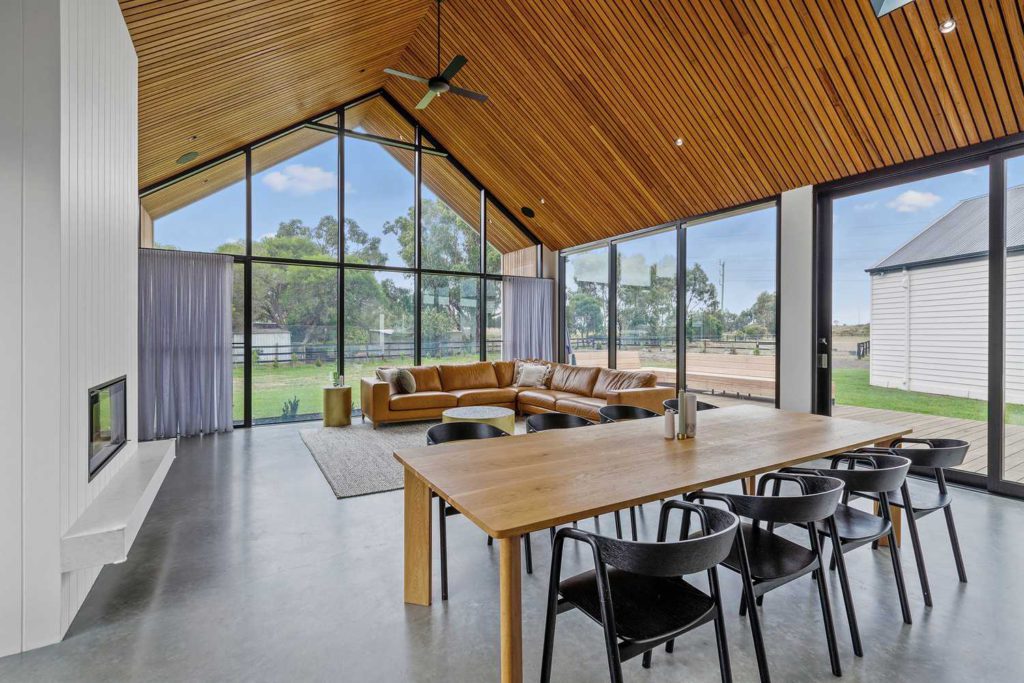Timber – a versatile and timeless material, has been a staple in human lives for centuries.
Timber is simply the wood from trees, felled, debarked, cut to a specific size and usually seasoned or kiln-dried to stop it from shrinking, bending or twisting out of shape.
From construction and furniture making to decorative applications, timber offers both durability and aesthetic appeal.
Let’s look at different aspects of timber, including its uses, preservation techniques, and specific applications such as decking, battens and ceilings, as well as innovative solutions for timber handling and transportation.
For example, Merbau, also known as Kwila, is a hardwood species native to Southeast Asia and the Pacific Islands. It is highly regarded for its strength, stability, and resistance to rot and termites. These characteristics make Merbau an excellent choice for outdoor decking, where it is exposed to the elements.
Its rich reddish-brown colour with yellow undertones adds warmth and elegance to any outdoor space – but – in common with any wood which is exposed, it really needs some protection.
Timber oil plays a vital role in preserving the quality and enhancing the longevity of wood for decking or other outdoor uses. It acts as a protective barrier against moisture, UV rays, and other external elements that can lead to decay, discolouration, and warping and penetrates deep into the wood, nourishing and sealing it from within
The best decking oil for Merbau wood helps their oils provide excellent UV protection, water repellency, and durability by providing superior nourishment and diffusion. Look out for the special formulation oils at your local hardware store.
Timber battens are widely used in various applications for their versatility and design appeal. Whether for cladding, screening, or decorative purposes, timber battens offer a unique touch to both interior and exterior spaces.
Such battens are commonly used for cladding buildings, adding texture and depth to the exterior façade. They can be arranged vertically, horizontally, or in creative ways to create a special style. They can enhance interior walls, creating focal points and adding visual interest. They can be applied as full-height wall features, wainscoting, or even as decorative accents.
Battens can make for stylish and functional fencing options. They can be installed horizontally or vertically to create a contemporary or traditional look, depending on your preference
These battens are also excellent for creating privacy screens and partitions in both indoor and outdoor spaces. They offer a balance between openness and seclusion, allowing light and airflow while maintaining a sense of privacy.
Another use is as a stunning option for timber ceilings. Whether in residential or commercial spaces, timber batten ceilings add warmth, character, and a touch of nature. They can be installed in different ways, such as parallel, herringbone, or diagonal, to suit different ideas.

A timber ceiling offers a visually striking feature in both residential and commercial spaces. The natural warmth and character of timber bring a sense of cosiness and elegance to any room. The grain patterns and textures of timber add visual interest and a sense of natural beauty to any space whether inside or outside.
Timber ceilings can be sensitive to moisture, so it’s essential to minimise direct exposure to water or high humidity levels. Use appropriate ventilation in bathrooms, kitchens, and other areas prone to moisture to prevent moisture buildup.
Depending on the type of finish used on your timber ceiling, periodic maintenance may be required. If the finish starts to wear off or if the timber becomes dull, consider hiring a professional to refinish the ceiling and restore its original beauty.
One aspect of timber which is often forgotten is that of getting the wood to the site in the first place. Innovative lifting solutions have been used over the years – from pulleys and tackle geared to make lifting easier by suspending the gear from nearby trees or buildings, to cranes and hydraulic lifting systems.
Efficient and safe lifting solutions are crucial for handling heavy and oversized loads of timber. Bubble cranes, also known as air-powered or pneumatic cranes, provide an innovative and versatile lifting option.
Bubble cranes are a type of lifting equipment that utilises compressed air or gas to generate lifting force. They consist of a flexible, inflatable bladder or bubble that expands and contracts to lift and lower loads. A bubble crane offers an alternative to traditional cranes, providing several advantages in terms of flexibility and portability.
They can be used in various environments and terrains, making them highly versatile. They can operate on uneven surfaces, including soft ground or rugged terrain, where conventional cranes may face limitations. Because they have a high weight-to-lifting capacity ratio, they can lift heavy loads while being lightweight themselves. This makes them suitable for applications where minimising equipment weight is important.
By using compressed air or gas as their power source, bubble cranes have a reduced environmental impact compared with cranes that rely on fossil fuels. They produce fewer emissions and are more energy-efficient, contributing to sustainability efforts and are relatively easy to set up and operate. They require minimal assembly and can be quickly inflated and ready for use. This saves time and labour in comparison with the installation and setup process required for traditional cranes.
With precise control over the lifting process that bubble cranes bring to the party, operators can adjust the lifting force and control the descent speed, ensuring safe and controlled lifting operations. This level of control is particularly advantageous when working with delicate or fragile timber materials.
These cranes are not just valuable for stacking and organising timber in storage yards or warehouses. Their precise control and manoeuvrability enable operators to stack timber materials in a way that maximises storage capacity and accessibility.
Given all this, bubble cranes are expensive bits of kit – so hiring them in for short-term jobs makes a lot of sense. Bubble cranes hire out at different rates depending on the specifications needed for the job – but the plant hire companies have specialist advice for anyone needing bubble crane or low loader hire.
Having the right professional know-how is important from which timber you want to buy and use through to how to transport and install it properly.
Remember, the world of timber offers a multitude of possibilities, and with the right knowledge and tools at your disposal, you can embark on exciting projects that showcase the beauty and versatility of this natural resource. Celebrate the highs and lows of timber as you create stunning spaces, elevate your designs, and leave a lasting impression.

